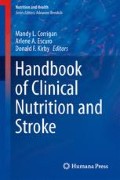Key Points
-
The evaluation and management of stroke in children is conceptually similar to adult stroke; whereas the basic pathophysiology, residual functional deficits, and rehabilitative strategies share common concepts; however, there are many important details that differ significantly, making the management of pediatric stroke a distinct area of expertise.
-
Common causes of childhood stroke include congenital heart disease, clotting disorders, metabolic disorders, mitochondrial disorders, sickle cell disease, and focal arteriopathy.
-
In the acute management of stroke, the dietitian’s main goal is to ensure optimal nutrition in order to promote healing and prepare the child for physical rehabilitation. Nutritional management in the rehabilitation or chronic phase targets long-term effects of stroke including swallowing problems, immobility, spasticity, limited physical activity, cognitive and behavior changes, limited weight-bearing through the lower extremities, pressure sores, constipation, and gastroesophageal reflux.
-
Nutrition support is typically provided enterally rather than parenterally unless the gastrointestinal tract is compromised. An interdisciplinary approach is the most effective method of evaluation of long-term feeding, nutrient intake, and growth monitoring.
-
Obtaining accurate growth parameters can be challenging, especially in children with long-term disability. In children with disabilities, triceps and subscapular skinfolds as well as arm-fat area may be better indicators of undernutrition than the standard weight/length or body mass index (BMI)/age chart. Children’s limited food preferences are often one of the biggest challenges for clinicians. Optimal nutritional management of the pediatric stroke patient requires knowledge of childhood-specific nutritional requirements, as well as normal and disease-specific growth and development considerations and cannot be based on adult standards or practices.
Access this chapter
Tax calculation will be finalised at checkout
Purchases are for personal use only
Abbreviations
- ADL:
-
Activities of daily living
- BEE:
-
Basal energy expenditure
- BMI:
-
Body mass index
- DRI:
-
Dietary reference intakes
- EER:
-
Estimated energy requirement
- GER:
-
Gastroesophageal reflux
- GI:
-
Gastrointestinal
- GT:
-
Gastrostomy tube
- MBS:
-
Modified barium swallow
- NG:
-
Nasogastric tube
- RDA:
-
Recommended dietary allowances
- REE:
-
Resting energy expenditure
- TEE:
-
Total energy expenditure
- TBI:
-
Traumatic brain injury
- WHO:
-
World Health Organization
References
Barkat-Masih M, Hamby DK, Ofner S, Golomb MR. Feeding problems in children with neonatal arterial ischemic stroke. J Child Neurol. 2010;25(7):867–72.
Stevenson RD, Roberts CD, Vogtle L. The effects of non-nutritional factors on growth in cerebral palsy. Dev Med Child Neurol. 1995;37(2):124–30.
deVeber GA, MacGregor D, Curtis R, Supriya M. Neurologic outcome in survivors of childhood arterial ischemic stroke and sinovenous thrombosis. J Child Neurol. 2000;15:316–24.
Robinson R. Pediatric stroke: differences from adult symptoms highlighted. Neurol Today. 2010;10(12):22.
Friedman N. Pediatric stroke: past, present and future. Adv Pediatr. 2009;56:271–99.
Bacani D, Garrin M, Mance M, Yanski A. Therapeutic hypothermia for neonatal hypoxic-ischemic encephalopathy. Nurse Currents. 2011;5(2):1–10.
Niklasch D. Induced mild hypothermia and the prevention of neurological injury. J Infus Nurs. 2010;33(4):236–42.
Wessel J. Nutrition in hypoxic-ischemic encephalopathy. Nurse Currents. 2011;5(2):12–4.
Marchand V, Motil K, NASPGHAN Committee on Nutrition. Nutrition support for neurologically impaired children: a clinical report of the North American Society for Pediatric Gastroenterology, Hepatology and Nutrition. J Pediatr Gastroenterol Nutr. 2006;43:123–5.
Kuperminc MN, Stevenson RD. Growth and nutritional disorders in children with cerebral palsy. Dev Disabil Res Rev. 2008;14(2):137–46.
Motil KJ. Developmental Delay. In: Corkins MR, Ballint J, Bobo E, Plogsted S, Yaworski JA, Seebeck ND, editors. The A.S.P.E.N. Pediatric Nutrition Support Core Curriculum. 2010;191–203.
Ludlow V, Randall R, Burritt E, Rago D. Estimating nutrient needs, pediatric module. ASPEN enteral nutrition practitioner tutorial project; 2010. http://www.nutritioncare.org
Calis EA, Veugelers R, Sheppard JJ, Tibboel D, Evenhuis HM, Penning C. Dysphagia in children with severe generalized cerebral palsy and intellectual disability. Dev Med Child Neurol. 2008;50(8):625–30.
Morgan AT. Dysphagia in childhood traumatic brain injury: a reflection on the evidence and its implications for practice. Dev Neurorehabil. 2010;13(3):192–203.
Prasse JE, Kikano GE. An overview of pediatric dysphagia. Clin Pediatr. 2009;48(3):247–51.
Gosa M, Schooling T, Coleman J. Thickened liquids as a treatment for children with dysphagia and associated adverse effects: a systematic review. ICAN Infant Child Adolesc Nutr. 2011;3(6):344–50.
Abbott Nutrition. Nutritional products; 2012. http://abbottnutrition.com/Products/Nutritional-Products.aspx
Mead Johnson. Nutritional products; 2012. http://www.meadjohnson.com/Brands/Pages/Products-by-Need.aspx
Nestle Nutrition. Nutritional products; 2012. http://www.nestle-nutrition.com/products/default.aspx
Nutricia North America. Nutritional products; 2012. http://www.nutricia-na.com/pages/products.htm
Author information
Authors and Affiliations
Corresponding author
Editor information
Editors and Affiliations
Rights and permissions
Copyright information
© 2013 Springer Science+Business Media New York
About this chapter
Cite this chapter
DeTallo, C., Henry, D., Miller, M. (2013). Pediatric/Adolescent Stroke. In: Corrigan, M., Escuro, A., Kirby, D. (eds) Handbook of Clinical Nutrition and Stroke. Nutrition and Health. Humana Press, Totowa, NJ. https://doi.org/10.1007/978-1-62703-380-0_8
Download citation
DOI: https://doi.org/10.1007/978-1-62703-380-0_8
Published:
Publisher Name: Humana Press, Totowa, NJ
Print ISBN: 978-1-62703-379-4
Online ISBN: 978-1-62703-380-0
eBook Packages: MedicineMedicine (R0)

